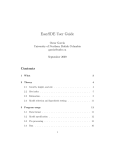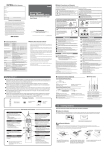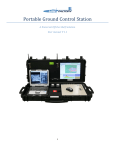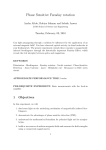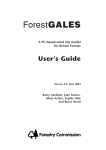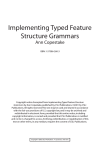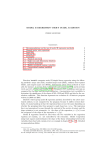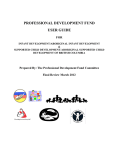Download EasySDE User Guide - University of Northern British Columbia
Transcript
EasySDE User Guide Oscar Garcı́a University of Northern British Columbia [email protected] July 2003 Contents 1 What 2 2 Theory 3 2.1 Growth, height, and site . . . . . . . . . . . . . . . . . . . . . 3 2.2 Site index . . . . . . . . . . . . . . . . . . . . . . . . . . . . . 4 2.3 Estimation . . . . . . . . . . . . . . . . . . . . . . . . . . . . 6 2.4 Model selection and hypothesis testing . . . . . . . . . . . . . 9 3 Program usage 9 3.1 Data format . . . . . . . . . . . . . . . . . . . . . . . . . . . . 9 3.2 Model specification . . . . . . . . . . . . . . . . . . . . . . . . 10 3.3 Pre-processing . . . . . . . . . . . . . . . . . . . . . . . . . . 12 3.4 Run . . . . . . . . . . . . . . . . . . . . . . . . . . . . . . . . 14 3.5 Results . . . . . . . . . . . . . . . . . . . . . . . . . . . . . . . 14 4 Graphing 15 1 1 What EasySDE is essentially a GUI front-end to some old software for developing forest height growth (or site index) models. Fairly sophisticated and statistically efficient methods are used, making good use of almost any kind of remeasurement data. The old software was not particularly user-friendly, which undoubtedly limited its popularity. EasySDE greatly simplifies the process. Its ease of use should compare favourably to most other site modelling procedures. In short, various parameterizations of the Richards equation can be used. For estimation, environmental and measurement error sources are modelled through a stochastic differential equation (SDE). All parameters are estimated simultaneously by maximum likelihood (don’t panic, all this will be explained shortly). Data can be two or more height-age measurements on any number of sample plots. Measurement intervals can vary, and may be of any length. Either permanent sample plot or stem analysis data can be used. Some methodological background is given in the next section. EasySDE user instructions follow. This should be more than sufficient for model development using the variants that past experience has shown to be the most useful. If you really know what you are doing, and feel adventurous, for added flexibility you might want to run directly the underlying programs. Or even hack into the code, or use some of its components for other purposes. Details are contained in the Advanced and Programmer Notes included in this distribution. All sources are freely available under the MIT license (www.opensource.org/licenses). The models and methods are described formally in Garcı́a (1983), and Seber and Wild (1989, pp. 354–356 and Appendix C), but what follows should be enough to get you started. Extensive experimental results are reported in Garcı́a (1999). Similar methods were used by Rennolls (1995). 2 2 2.1 Theory Growth, height, and site On a given site, and under “average” weather conditions, the expected height growth depends on the current height: dH = f (H) , dt (1) where H is top height and t is time (or age). It is usually assumed that, within limits, other stand variables such as density do not significantly affect top height. It might be argued that growth also depends on age. But in fact, age, as elapsed time since birth, does not have a physical presence at any given time — other than perhaps in the number of growth rings. Therefore, it can hardly have a direct causal effect. Only accumulated changes reflected in the current state of the stand can be causes. In principle, physiological tissue aging might have some influence on growth rates. For the most part, however, tree size must be the dominant variable. Starting from some initial height H0 at time t0 , accumulation (i.e., integration) of the growth rate in (1) produces the height H1 at some other time t1 . This can be calculated taking advantage of (1) being a “separable differential equation”: H1 H0 dH f (H) dH f (H) = = dt t1 t0 dt = t1 − t0 . If we can analytically integrate the left-hand side, and then solve for H1 , we obtain a formula for H1 as a function of t1 , t0 , and H0 . A flexible and commonly used model has f (H) = ηH m − κH. It was proposed in this form by von Bertalanffy in the 1930’s, not just with m = 2/3 as is often thought (von Bertalanffy, 1938, 1949), and was popularized for plant growth by Richards (1959). Introduced in forestry by Pienaar and Turnbull (1973), for some reason it is sometimes called the “Chapman-Richards” 3 model. It will be convenient to use a power transformation H c , with c = 1 − m, and write it as dH c = b(ac − H c ) . dt (2) The equivalence can be verified by differentiating on the left-hand side, and re-arranging. Integrating and solving for H, as explained above, gives the height-over-age equation: H = a[1 − (1 − H0c /ac )e−b(t−t0 ) ]1/c . (3) I have omitted the subscript 1 to simplify. We shall also refer to t as age, although it only needs to be a relative time or nominal age; shifting by a constant does not make any difference. In (3), often H0 and t0 are taken as zero, forcing the curve to go through the origin. More generally, they may represent some initial size at a certain age. This is a typical sigmoid curve. The parameter a is the asymptote, b is a “speed” factor, scaling the time axis, and c is a shape parameter determining the relative height of the inflection point. 2.2 Site index Top height growth is widely used as an indicator of site productivity. The advantage over more direct measures, such as volume production, is that it is less affected by stand density management treatments. It is assumed that height-age curves, e.g. (3), vary across sites. Depending on site quality, the curves lie at different levels, without intersecting each other. The curves may be labeled in various ways, a common one being by the height reached at some specified reference or base age: the site index. Mathematically, this corresponds to a one-parameter family of curves. That is, the curve equations for different sites differ only in the value of one scalar parameter. For instance, in (2) and (3) one of the parameters a, b, or c, may change with site quality, while the others are common to all sites. More generally, this may happen after a re-parameterization: any or all of a, b and c can be fixed functions of some other parameter that varies with site. 4 We call a site-dependent parameter local, being specific to a sample plot, and the others global, pertaining to the model as a whole. The relationship between the local parameter and the conventional site index S is found by substituting the base age ts in (3): S = a[1 − (1 − H0c /ac )e−b(ts −t0 ) ]1/c . (4) In simpler cases (4) can be algebraically solved for the local parameter, and this substituted in (3) to obtain a height-age equation indexed by S. A numerical solution may be needed in other instances. All this is fairly straightforward in a deterministic world, or when dealing with “expected” trends as up to here. With actual stand data we need to be more precise. Implicit in the traditional concept seems to be the idea that site curves and site index represent some sort of average over hypothetical stands that might grow in the site. That is, site index is a property of the site. More recently, some researchers have been thinking of site index as the actual height reached by a specific stand at the base age. A property of the stand. Failing to distinguish between these two different definitions, which we might dub “site site-index” and “stand site-index”, has caused a great deal of confusion and unnecessary controversy (see, for instance, Bailey and Cieszewski, 2000, and references therein). We take the site site-index view. Specifically, Site index is the most likely top height at a base age among any hypothetical stands (of a given species, etc.) that could grow in a site 1 . And similarly for other ages. At least in this view, the site index base age is essentially arbitrary, a device for assigning a number to each curve in the family. Therefore, modelling approaches where results change with the chosen reference age are, at best, ugly. Our methods are strictly base-age invariant, in the sense of Bailey and Clutter (1974). Warning: As with any single-number measure, the concept of site index can fail if pushed too far. It can be a good indicator of relative productivity within biogeoclimatic regions where growth patterns and limiting factors are similar. Otherwise, not just the level, but also curve shape may vary in such 1 I could have said “expected” instead of “most likely”. Mean and mode converge to the same value as sample size increases, so, presuming an infinite number of hypothetical stands, it makes no difference in the definition. There are differences in estimation situations, as discussed later. 5 a way that crossings occur. An appropriate stratification should be used. Alternatively, multidimensional indicators might be possible, although little or no research in this direction appears to have been done. An experimental model variant with two local parameters is included in this package. 2.3 Estimation Rational parameter estimation requires some sort of model for the variability of the observations. Experience suggests that moderate deviations from the assumptions — e.g., additive errors, uniform variance, independence, normality, etc. in regression — may not be overly critical for the quality of the estimates. A rough characterization of the error structure is nevertheless desirable. It is clear, for instance, that the deviations of a stand from the model of equation (3) would tend to increase with time, and that they are not statistically independent. This because the “error”, due among other things to weather fluctuations, accumulates over time. Ordinary least-squares is therefore relatively inefficient. Seber and Wild (1989, Ch. 7) review approaches to modelling this kind of data, and others are found in the forestry literature. Many, such as autoregressive and mixed effects models, trade a somewhat crude representation of error structure for the convenience of using standard statistical packages. We try a more realistic stochastic model that requires special-purpose software. Hopefully, EasySDE now makes its application not more difficult than other methods. For each sample plot, we represent the effects of “environmental noise”, mostly weather, as a perturbation added to the right-hand side of (2). The perturbation is assumed to be a continuous random process, with values that are independent for non-overlapping intervals. Technically, what is called a Wiener, white noise, or Brownian motion process: √ dH c = b(ac − H c ) + 2bσ ẇ(t) . dt (5) Here ẇ(t) is the standard (mean 0, variance 1) Wiener process, and σ is a new parameter determining the perturbation intensity or variance2 . This is √ The factor 2b does not appear in Garcı́a (1983). If I remember correctly, it was introduced here to simplify the programming, or maybe for some other obscure reason. 2 6 called a stochastic differential equation (SDE). To keep things “simple”, we neglect any correlations across plots. In addition, we recognize that an observed stand top height hi may differ from the real Hi due to measurement and sampling error. For mathematical convenience we assume hci = Hic + σm i , (6) where the i are independent standard normal variables, and σm is another parameter to be estimated. This makes the error slightly higher for larger heights (standard error approximately proportional to Hi1−c ), which seems reasonable. Finally, it might happen that growth perturbations are higher at the seedling stage than later on. An optional additional parameter σ0 may be used to represent extra variability over some time previous to the first measurement. The general model has then 8 “basic” parameters: a, b, c, t0 , H0 , σ, σm , and σ0 . In a specific model version or variant, some of these parameters may be fixed (often zero), global, or local. They may also be some function of other new global and local parameters — examples later. Actually, a “local parameter” represents many parameters, one for each sample plot. Typically, one needs to estimate hundreds of parameters. Although for most applications only values for the globals among the first five above are used. The data consists of a number of sample plots, each with a sequence of ageheight observation pairs (ti , hi ). We estimate the parameters by the method of maximum likelihood (ML). It in based on calculating the probability, under the model, of obtaining the observed data. Considered as a function of the parameters, substituting the given data, this is the likelihood function. The ML estimates are the parameter values that maximize the likelihood function. ML estimation has a number of nice statistical properties. Two characteristics are particularly attractive for this kind of application. First, no matter how complicated a model, the procedure is well defined: one “simply” obtains the likelihood function and finds a maximum. Second, it is invariant under transformations, that is, the ML estimate for any function of the parameters equals that function of the parameter ML estimates. This is convenient where parameterizations are essentially arbitrary: should we 7 get good estimates for the site index, for its logarithm, for a local parameter, for the height at a certain age? Unlike with other methods, all these are simultaneously possible and compatible. The likelihood function is obtained through integrating the SDE (5), and incorporating the distributions implied by (6). If you must, see Garcı́a (1983) or Seber and Wild (1989) for the gory details. A modified full Newton method, using first and second derivatives, is used to improve efficiency and reliability in minimizing the negative of the log-likelihood over hundreds of variables (parameters). The implementation makes use of the special structure of the problem, with partitioning strategies to take advantage of sparsity in the matrix of second derivatives. For details see Garcı́a (1980), and the Advanced and Programmer Notes in this package. It might be worthwhile to clarify a couple of things that have caused some confusion. I probably shot myself in the foot by delving in the Biometrics paper in theoretically interesting but practically less important limitations of the model. Some have misunderstood this and dismissed the whole approach as useless, so let us try to keep things in perspective. No model is perfect, nor it should be: perfection has an unacceptable cost in terms of parsimony and estimation efficiency. The first quibble was mentioning that (5) cannot be strictly correct; the additive random perturbation could conceivably make the (transformed) height to go negative. True, but in reality unlikely and inconsequential. The same thing is routinely ignored without a second thought when using regressions with non-negative variables. The second issue may be a little more troubling, at least from a methodological point of view: Often, although not always, the estimate of either σ or σm turns out to be zero. Apparently the data does not provide sufficient information to separate the different variance components. Of course, the problem would go away if either one of the two sources of variability is ignored, as has been done in all the other methods I know off. At any rate, this does not seem to have an appreciable impact on the estimates for the parameters of interest (a, b, c, t0 ), and might be taken as a warning against the temptation of introducing even more “realistic” error structures. Actually, measurement/sampling error in stem analysis is small relative to that in sample plots (although the risk of bias is higher), and there it might not be a bad idea to fix σm = 0. 8 2.4 Model selection and hypothesis testing Models with the same number of parameters can be compared and chosen according to the highest value of the computed likelihood, or of its logarithm, the log-likelihood. In comparing models with different number of parameters, extra flexibility needs to be penalized. Various theories suggest adding penalties of one-half to three log-likelihood units per parameter. Akaike’s information criterion (AIC), perhaps the most popular, prescribes one unit. Note that the likelihood value by itself is essentially meaningless, it is the relative values, or differences in the logarithms, that are important. For hypothesis testing, one approach considers a log-likelihood difference of about two units as “significant”. More orthodox is a likelihood-ratio test. It is based on the fact that twice the log-likelihood difference is asymptotically distributed as a χ2 with degrees-of-freedom equal to the difference in number of parameters. For examples see Garcı́a (1999). 3 3.1 Program usage Data format The data must be arranged in a text file with three columns: plot number, age, and top height. Plot numbers must be integers, with up to 9 digits. The other values are free format, and columns may be separated by any number of spaces and/or tabs. Each row corresponds to one measurement date, with the sequence of plot measurements ordered by increasing age. Different plots must be separated by a blank line. See test.dat for an example. Before going any further, it is a good idea to plot the data to check for “funnies”. SitePlot may be used for this. A detailed description is in Section 4, but for plotting just data it should be self-explanatory. A note on stem analysis data. Often heights are interpolated for every year, using methods such as those described by Dyer and Bailey (1987). Only values for the actual crosscuts should be used here. Because in general the tree tip corresponding to the ring count at a crosscut is located some 9 distance above the crosscut, crosscut heights may be adjusted as shown by Dyer and Bailey (1987). However, as suggested by Jim Goudie (BC Ministry of Forests, quoted by Nigh (1995)), a simpler and probably better method is to use the crosscut height, reducing the ring count by 0.5 years. 3.2 Model specification On running EasySDE, the window in Figure 1 appears. The items in it are as follows: Figure 1: Stage 1: Model specification window Title. One line of optional descriptive information to be printed at the top of the program output. 10 Binary files. If checked, the data and local parameter estimates from the last run are used. The model version in the new run must use the same local parameter(s). File. Name of the input data file. Scaling. The ages and heights in the data file are divided by these values. Convergence is usually faster and more reliable if the scaled ages and heights are not too far from unity. If the scale factors are different from one, the initial estimates and the output correspond to the scaled model. Values such as 10 or 100 make easy the scaling back. Model. Click to select a model version. The Gi stand for global parameters, and the Li for local parameters. A number of models are available in EasySDE: ALOCAL has a as local parameter, and is forced to pass through the origin. It produces anamorphic site index curves. A-T0 to A-T0S0 include non-zero origin parameters, and/or the additional initial variance σ0 . ALOCBH is for data using breast-height age; it forces a height of 1.3 at age zero (before scaling). BLOCAL to BLOCBH are similar, but taking b as the local parameter. The resulting curves are “polymorphic”. Actually, proportional along the t axis. LINEAR and COMP are more general models, where curve shape varies in a more flexible way with site. At the cost of an extra parameter. Unfortunately, only a numerical solution for the local as a function of site is possible, so they are not as convenient for many uses3 . They can be useful for assessing the adequacy of the simpler models, and as a last resort if the others do not work. COMP was used in Garcı́a (1996). Finally, ABLOCALS has both a and b as local parameters, so it does not produce traditional site index curves. It may be useful for hypothesis testing and experimentation. Graphing the relationship between the estimated a and b might suggest appropriate re-parameterizations. 3 Conjecture: there are no “truly” polymorphic models with a base-age invariant explicit expression for the indexing parameter in terms of site index. 11 These are the models that generally have been found most useful in practice. Other variants can be implemented with just a little more effort; see the Advanced and Programmer Notes. It is recommended to start with the simplest model in each class (ALOCAL or BLOCAL), and possibly use the estimated parameters as starting point for the more general ones. The Binary files option is useful there. Initial estimates. These are the starting points for the likelihood optimization iterations. They must correspond to the specified scaling, if any. For the local(s), a same value is initially used for all plots. Tab and Shift-Tab may be used to move among the entry fields. Convergence can be slow or fail if initial estimates are not good enough. If possibly, try stepping through models of increasing complexity, using previous estimates as starting points. Using Binary files takes advantage of the previous individual-plot locals. It is also a good idea to try several starting points, to (partially) guard against local optima. Some suggestions when starting from scratch: For a, guess a reasonable height upper bound. Parameter c lies usually between 0.5 and 1; try 0.7. Try the reciprocal of the base age for b. The σ’s are a little trickier; with decent scaling something around 0.05 should be OK. Help. Displays an abbreviated version of this section. Quit. As it says. Next. Advances to the next stage. 3.3 Pre-processing On clicking Next, the information is checked, and prepared for use by the main estimation program. If there are no missing or incorrect entries in the Model window, the window in Figure 2 appears. 12 Figure 2: Stage 2: Data pre-processing window. No user input is required. The input data file is checked for consistent plot numbers and increasing ages. If there are no error messages, the number of plots is displayed, and we can go to the next stage by clicking Next. The contents of the message window can be saved to a file through the Save button. If you must know, the front-end runs DataPrep.exe, which reads the input data file and generates intermediate files with the data (DATA.$$$, binary), the locals (PARS.$$$, binary), and other info (CTRL.$$$, text). If everything goes well, these are then passed on to SDEfit.exe, which does the hard work. The final local estimates and other information are left in PARS.$$$, and results in REPORT.$$$ (a text file). There is a little more flexibility when running these programs manually, specifically, a list of plot-specific local initial estimates can be used; see the advanced notes. 13 3.4 Run The same window is then used to display the iteration log as the optimization proceeds. To monitor progress, values for the parameters and for the function being minimized (which is -2 times the log-likelihood) are shown for each iteration, together with some other more esoteric information. Most relevant, the contribution to the objective function and the local parameter estimates for a few plots are shown, followed by iteration number, function, and global parameter values. The run should be possible to be aborted by clicking the Quit button (but it isn’t!). Otherwise, the program runs for up to a maximum of 200 iterations. If this happens try a better starting point and/or better scaling. Clicking Next takes us to: 3.5 Results A similar window displays the final results report. The report starts with the run identification, and the termination condition: “CONVERGED” for a successful run. For each plot, the following is shown: Plot number. Number of measurements. Contribution to -2 times the log-likelihood (large values flag outliers). Local parameter(s) estimate(s). Their approximate standard error. An estimated site index for each plot can be obtained from the local parameter using (4). General info follows: Number of plots. Total number of measurements. Log-likelihood. Then, info on the global parameters: Estimates. Approximate standard errors. Matrix of approximate correlations between them4 . Finally, for the local parameter(s): Average of the estimates. Mean standard error. Mean correlations among local parameters. Mean correlations between local and global parameters. 4 As mentioned at the end of Section 2.3, often one of the variance estimates turns out to be zero. Take with a pinch of salt. 14 Note that all results involve the specified scaling factors, if any. Back scaling can be figured-out by substituting in (5) the age and height divided by the respective factors. Can also be obtained from the SitePlot program, see below. Before exiting, the user is prompted to optionally save the report, if not already saved. 4 Graphing SitePlot aids in plotting the data and site index curves. Running SitePlot brings up the window in Figure 3. It generates commands for gnuplot, a free graphing program (included). The first part is similar to EasySDE. The Title appears at the top of the graph. Only models 1 to 12 are supported. Scaling factors and scaled parameter values can be used. It is possibly to plot just data, just curves, or both. Once the parameters are given, the site index equation can be displayed with the Show equation button. This gives top height as a function of age, site index, and index age (Section 2.2). It is in gnuplot format, which is fairly standard except for using ** for exponentiation. On the lower part of the window, labels and ranges for the Age and Height axes can be given or changed. Any strings can be used for the labels. If a range limit is left blank it is calculated by gnuplot automatically from the data and/or function values. The age limits must be given when not plotting data. For plotting site index curves one needs the index age, the range from lowest to highest site index, and the site index interval between the curves. Finally, we may choose to draw a grid or not, and different line types for the curves can be selected (enter test in gnuplot to see the types available). If everything goes well, on clicking OK gnuplot is executed, and the graph is displayed. The user is left in gnuplot, where the graph can be embellished, printed (right-click on the graph window), saved in various formats, etc. Enter set terminal and help terminal to see the output formats available. 15 Figure 3: Graphing with SitePlot. For instance, entering set output ’filename.eps’, followed by set term post eps 20 and replot, produces a good quality Encapsulated PostScript file. Gnuplot is an excellent general-purpose graphing program, well worth learning. See www.gnuplot.info. There is a good brief tutorial at www.duke.edu/˜hpgavin/gnuplot.html. The gnuplot commands are left in the file siteplot.plt. This can be loaded from gnuplot, possibly after manual editing. The gnuplot executable is Wgnuplot.exe. 16 References Bailey, R. L., Cieszewski, C. J., 2000. Development of a well-behaved siteindex equation: jack pine in north-central Ontario: Comment. Canadian Journal of Forest Research 30, 1667–1668. Bailey, R. L., Clutter, J. L., 1974. Base-age invariant polymorphic site curves. Forest Science 20, 155–159. Dyer, M. E., Bailey, R. L., 1987. A test of six methods for estimating true heights from stem analysis data. Forest Science 33, 3–13. Garcı́a, O., 1980. A stochastic differential equation model for the height growth of forest stands. Presented at the 5th Australian Statistical Conference, Sydney. http://web.unbc.ca/˜garcia/unpub/oz80.pdf. Garcı́a, O., 1983. A stochastic differential equation model for the height growth of forest stands. Biometrics 39, 1059–1072. Garcı́a, O., 1996. Toward new site index curves for Douglas-fir in the Netherlands. Working paper, Royal Veterinary and Agricultural University, Unit of Forestry. http://web.unbc.ca/˜garcia/unpub/dfsite.pdf. Garcı́a, O., 1999. Height growth of Pinus radiata in New Zealand. New Zealand Journal of Forestry Science 29 (1), 131–145. Nigh, G. D., 1995. Compatibility improvements and bias reduction in heightage models. Research Report 03, British Columbia Ministry of Forests, Research Branch. Pienaar, L. V., Turnbull, K. J., 1973. The Chapman-Richards generalization of von Bertalanffy’s growth model for basal area growth and yield in evenaged stands. Forest Science 19, 2–22. Rennolls, K., 1995. Forest height growth modelling. Forest Ecology and Management 71 (3), 217–225. Richards, F. J., 1959. A flexible growth function for empirical use. Journal of Experimental Botany 10, 290–300. Seber, G. A. F., Wild, C. J., 1989. Nonlinear Regression. Wiley. von Bertalanffy, L., 1938. A quantitative theory of organic growth (Inquiries on growth laws. II). Human Biology 10, 181–213. von Bertalanffy, L., 1949. Problems of organic growth. Nature 163, 156–158. 17

















